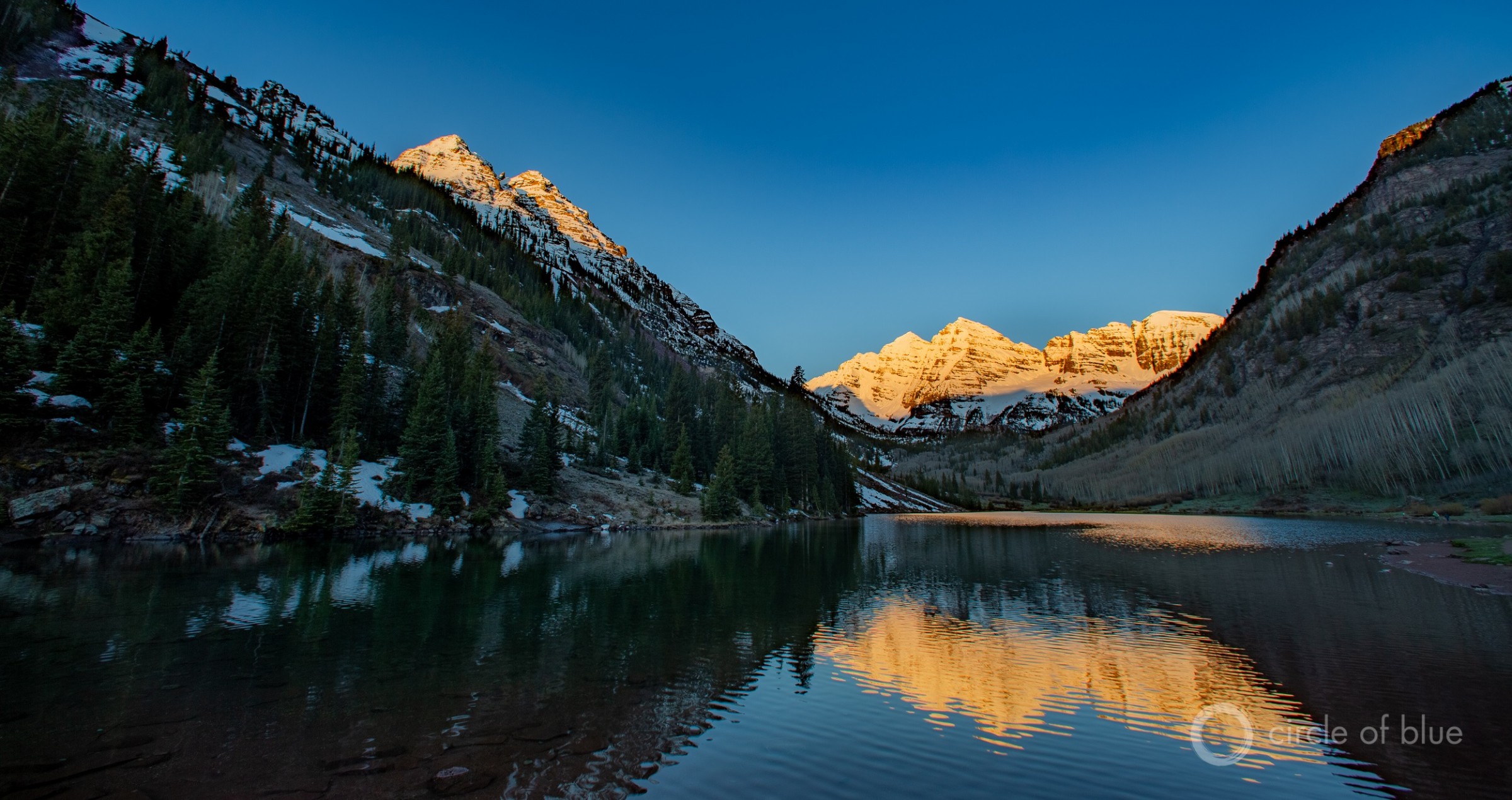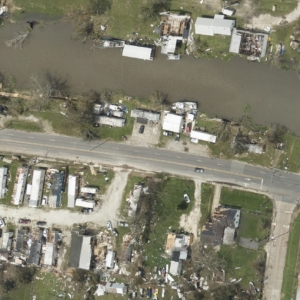Computer models inform key decisions in the Colorado River basin. But they cannot predict the future.

Precipitation in the mountains of Colorado is a source of uncertainty for water availability in the Colorado River basin. Photo © J. Carl Ganter/Circle of Blue
- The Bureau of Reclamation’s 24-month study, in the simplest terms, projects water levels for the next two years at 12 federal reservoirs in the Colorado River basin, including Lakes Mead and Powell, the country’s largest reservoirs.
- Typically nested in wonkish obscurity, the latest 24-month study acquired newfound public prominence in recent weeks. The August results are the most important of all the months because they determine how much water will be released in the following year from Mead and Powell, both of which sit at record lows.
- More eyes than usual on a technical product that was designed to guide reservoir operations means more potential for misinterpretation, especially by people unfamiliar with the study and its assumptions.
By Brett Walton, Circle of Blue – September 1, 2021
Every month the Bureau of Reclamation attempts to peer two years into the future of the Colorado River and its reservoirs.
Reclamation’s 24-month study is a staple forecasting product for the federal agency that manages a chain of dams in the watershed, including those that control lakes Mead and Powell, the country’s largest reservoirs — and currently two of its most consequential. The reservoirs are a key source of drinking water for about 40 million people, plus they store water that irrigates millions of acres of farmland and generates electricity for the Southwest. The reservoirs are also alarmingly dehydrated right now — about one-third full, the lowest since they were first filled. The entire basin is on alert.
The 24-month study, in the simplest terms, projects water levels for the next two years at 12 federal reservoirs in the Colorado River basin. Produced monthly, it’s one of several forecasting products that give water managers a sense of possible futures. It is also the foundation of essential water management decisions in the basin. Reclamation’s other forecasts, updated less frequently, look at mid-term (five years out) and long-term (multiple decades) scenarios.
Typically nested in wonkish obscurity, the 24-month study acquired newfound public prominence in recent weeks. The August results are the most important of all the months because they determine how much water will be released in the following year from Mead and Powell. Because Mead is so low, the August results triggered the first-ever Tier 1 shortage on the lower Colorado River, a declaration that means mandatory cuts in water deliveries in 2022 to Arizona, Nevada, and Mexico. Because Powell is so low, dam managers will release a comparative trickle of water next year, so little that Mead is likely to plunge even lower.
It’s important to understand that we’re not saying that this is what we think is going to happen this year.” — Carly Jerla, Bureau of Reclamation
More eyes than usual on a technical product that was designed to guide reservoir operations means more potential for misinterpretation, especially by people unfamiliar with the study and its assumptions. Carly Jerla, Reclamation’s senior water resources program manager, said that the study has its defined uses but also its limits.
“It’s important to understand that we’re not saying that this is what we think is going to happen this year,” Jerla told Circle of Blue about the reservoir levels outlined in the 24-month study. “We’re not saying, ‘Plan for this and only this because we have crystal ball knowledge of what is going to happen.’”
Reclamation’s models, in fact, are not a crystal ball. Critics say that they are not pessimistic enough about the potential for extremely dry years. But as the Colorado River basin dries due to a warming planet, Jerla and others are actively considering how best to convey to the public and water managers alike the looming risks to water supplies and to prepare people, at least mentally, for the possibility that reality could turn out much worse than the forecast had projected.
Future Imperfect
Jerla has worked for Reclamation since 2005 and is intimately acquainted with the computer models that underpin the reservoir forecasts. Since June she has been leading federal efforts to update operating rules for Colorado River reservoirs.
Current reservoir operating rules — the water release schedules for Mead and Powell — are directly influenced by the 24-month study, which has been around since the 1980s. The shortage declaration that was announced on August 16 is based on the “most probable” projection of Mead’s water level at the end of the year. Determining what is most probable is where the modeling comes in.
In an ideal world, one without any uncertainty, weather forecasts would perfectly align with actual weather. Snow would fall where it was predicted, in the quantities that were anticipated. Heat waves would be foreseen well in advance. Dry months, like those that happened this spring and zapped the region’s snowpack, would not be a surprise. Comforting as that might be, we do not live in that world.
Accurate mid-term weather forecasts, those that extend out a couple weeks and up to a year, are notoriously difficult to achieve, said Jeff Lukas, an independent climate researcher in Colorado who has worked in the basin for 20 years. It’s especially true in the mountainous terrain of Colorado and Wyoming, where the Colorado River and its main tributaries have their headwaters. Well-known seasonal patterns like the cyclical warming of the eastern Pacific during El Nino years can indicate wetter or drier, but without substantial precision.
Because the future is hazy, the models instead rely on the recent past as a guide, Lukas said. “We’re basically saying in the absence of real prognostic information, we’ll substitute history.”
[bctt tweet=”The Bureau of Reclamation’s 24-month study informs key decisions in the Colorado River basin. But it cannot predict the future. ” username=”circleofblue”]
Here’s how that works. The 24-month study process begins with the Colorado Basin River Forecast Center, a team of scientists operating within the National Oceanic and Atmospheric Administration. Their task is to assess what the rivers might do.
The River Forecast Center starts with current land and water conditions: soil moisture, snowpack, stream flow. From that baseline hydrologists feed their model, one by one, with historical weather observations from the years 1981 to 2015. In effect, it’s as if the temperature and precipitation from each year were repeated in today’s world. That produces 35 possible hydrological futures, each representing the past laid on top of the present.
The Bureau of Reclamation team takes those hydrological futures and uses them in its model of the Colorado River system. The aim of this system model, which includes water inflows and water uses, is to simulate reservoir levels as well as hydropower generation. Fed by the output from the hydrological model, the system model also produces future scenarios, called runs.
The middle result — the most probable — is the one that is presented in the main 24-month study report. It’s the result that determines how Mead and Powell will be operated. It’s called the most probable because it’s in the middle, if each of the runs was ordered from wettest to driest. It means that historically half the time it was wetter than the middle result and half the time it was drier.
There are drawbacks to this approach. The runs are not assessed as to how likely they are to occur, which means that a repetition of each of the past years is considered equally likely. The problem: there are more wet years in the 1981 to 2015 period than dry ones. (Runoff in 1983, for instance, was so extremely high that it almost broke Glen Canyon Dam.) Because of this imbalance, the middle result is arguably skewed toward wetter conditions, Lukas said.
Jerla said there is no scientifically valid way to privilege the likelihood of one outcome over another.
An update of the River Forecast Center’s data sets will soon help reduce the skew. Cody Moser, a senior hydrologist at the Center, told Circle of Blue that data from the years 2016 through 2020 will be added this fall. Instead of 35 historical hydrologies fed through the models, there will be 40. Adding the drier recent years will push the most probable outcome to a drier result, with reservoir projections in the 24-month study likely pushed downward at the same time.
“We’re accounting for more recent weather with this model update,” Moser said.
We’ve been arguing that their results aren’t stressful enough and that they present an overly rosy picture of the future.” — Brad Udall, Colorado State University
The 24-month study is most associated with the most probable scenario. But recently Reclamation has expanded its offerings to include two other reservoir scenarios, now produced monthly: the minimum probable and the maximum probable. The minimum probable is the tenth percentile, meaning the third or fourth driest of those 35 historical hydrologies. The maximum probable is the ninetieth percentile, or the third or fourth wettest historical hydrology.
For the minimum probable, the tenth percentile of flows is used in the first year of the 24-month study, but the second year of the study is calculated with the twenty-fifth percentile, under the assumption that consecutive extremely bad years would not happen.
If you look only at the most probable result, you’re not seeing how bad things might plausibly get. Lake Mead today, when it is one-third full, sits at elevation 1,068 feet. The most probable elevation for July 2023 is 1,037 feet, when Mead would be 26 percent full. The minimum probable elevation for that date is 1,027 feet, when the gasping reservoir would be 23 percent full.
That’s a significant difference in elevation, and if the drier scenario came about it would change basin operations. But even the minimum probable has a flaw. It is not as pessimistic as it could — or maybe should — be.
“The minimum probable does not represent a worst-case scenario,” Jerla said. “If you wanted to be the ultimate pessimist, which I think probably makes sense given where the system is, things could be worse than what is provided in that minimum probable because it is only the tenth percentile.”
In other words, the minimum probable is not the minimum possible. There have been years in the last two decades with worse river flow conditions than what is represented by the minimum probable. Things could be drier still.
As Jerla puts it regarding the minimum and maximum probable: “There is an area above and below those that have futures that folks should be aware of.”
The Danger Zone
Critics of Reclamation say that the modeling outputs do not delve deeply enough into those danger areas. The area above the maximum probable is not relevant today — it only becomes a concern when the reservoirs are close to overtopping, which is not going to happen any time soon.
The risk of several really dry years, however, is not only immediately relevant but imperative for officials and the public to consider, argues Brad Udall, a water and climate scientist at Colorado State University. Reclamation should be looking in that direction, he says.
“We’ve been arguing that their results aren’t stressful enough and that they present an overly rosy picture of the future,” Udall told Circle of Blue. In his own performance analysis of the 24-month study, Udall found that the minimum probable and most probable scenarios over the last decade tended to overstate reservoir levels compared to what actually occurred. “There’s too much water in these forecasts,” he said.
An example of that happened this spring. The most probable forecast from the April 24-month study projected Lake Powell’s elevation at the end of August to be 3,559 feet. In reality, the reservoir now sits at 3,549 feet, a full 10 feet lower than the most probable and much closer to the minimum probable forecast of 3,546 feet.
The reason for this rapid decline: a much drier spring and early summer combined with dry soils.
Reclamation already runs its five-year projections with what it calls “stress test” hydrology. This scenario is a replication of the years 1988 to 2019, and represents hotter and drier conditions that have settled over the basin. Udall and others argue that Reclamation should consider running its models with an even more stressful test: the years 2000 to 2004, the last time that Lake Powell almost crashed.
“That five-year period is really unique,” Udall explained. Annual runoff averaged 9.4 million acre-feet, a fraction of what coursed through the river throughout the last century. The average annual runoff in the years for the stress test hydrology is about 13.3 million acre-feet. That makes the first years of this century unique, Udall said. And frightening. “There’s nothing like it in the 20th century. It’s stunning how bad a period it is, and we could be in the middle of that right now.”
Jerla said that Reclamation is looking at ways of expanding the worst-case scenario information that is used in the studies and made available to the public. The 24-month study probably won’t be the place for that, she said. The most probable forecast is baked into reservoir operating agreements and is unlikely to go away.
“Everyone is focused on the most probable because it’s enshrined in current policy, not because it’s the best way to look at the near-term future,” Lukas said.
Reclamation officials instead aim to include the information in the mid-term projections, those that provide probabilities for the next five years. Jerla said that staff are still discussing the best ways to expand the range of information they are providing and explain the results.
The next update of the five-year projections will come out in early September. Five years is a tricky time frame to analyze, Jerla said. It’s far enough in the future that current conditions lose their predictive power. But it’s close enough to be relevant for farmers, city utilities, and marina operators — all of whom need to plan for near-term water supply. Jerla and her colleagues are trying to thread that needle, thinking hard about how to “provide the public with a good understanding of future outcomes and future risks without confusing the heck out of them.”
Brett writes about agriculture, energy, infrastructure, and the politics and economics of water in the United States. He also writes the Federal Water Tap, Circle of Blue’s weekly digest of U.S. government water news. He is the winner of two Society of Environmental Journalists reporting awards, one of the top honors in American environmental journalism: first place for explanatory reporting for a series on septic system pollution in the United States(2016) and third place for beat reporting in a small market (2014). He received the Sierra Club’s Distinguished Service Award in 2018. Brett lives in Seattle, where he hikes the mountains and bakes pies. Contact Brett Walton





